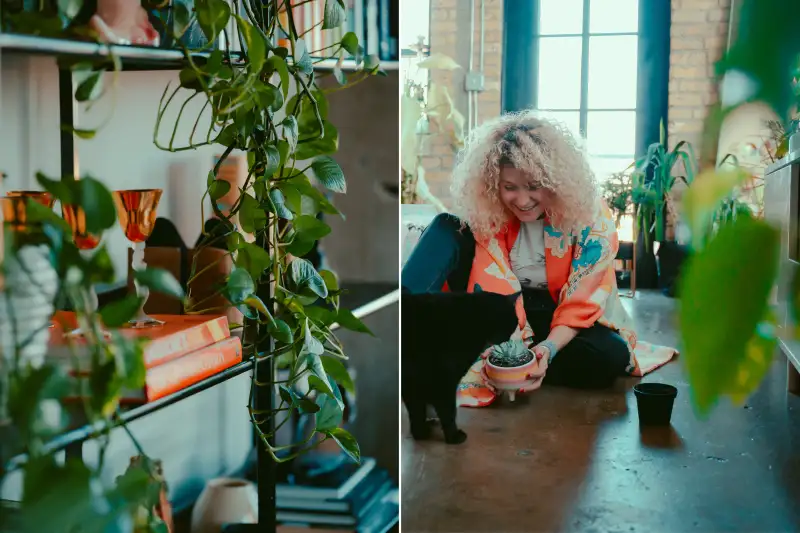Millennials Aren't Buying Homes, but They Are Spending Thousands on Houseplants

A generation ago, 20-somethings living in rental apartments usually saved to buy their first home. Elizabeth Margulis is saving for her next houseplant.
Since moving into her Chicago two-bedroom three years ago, the 28-year-old wardrobe stylist has bought about 30 plants — spending a total of $1,500, nearly as much as her $2,000 monthly rent. Today they form a wall of green along the sill of the L-shaped bank of windows in her living area “to create their own ecosystem,” she says.
To save for her next purchase, a larger cactus that costs upwards of $250, she is cutting out coffee shops and cooking at home a couple days each week. While she would like to own her own home someday, right now her sunny south-facing windows are more important. “Light was a big requirement for me when looking for a space,” she says.
She’s not alone. For many 20 and 30-somethings dormers and a white picket fence seem impossibly out of reach. Making rentals feel more inviting and homey through greenery is a more realistic alternative. They argue the right plants (and modern planters) can turn tiny apartments into aspirational urban jungles. Cluttered nooks look suddenly chic with a monstera or fiddle leaf fig nearby. To achieve the right look, some young renters are spending hundreds or even thousands of dollars — the kind of money homeowners might spend renovating a kitchen or bathroom.
“We see a ton of people that buy plants before they buy a home,” says Justin Mast, founder of Detroit-based Bloomscape, an online plant delivery service that launched in 2017 and caters to millennials. “Plants really fit into this different life stage.”
Millennials account for about a quarter of the $48 billion spent on lawn and garden products in 2018, even though they have lower household incomes than older generations, according to data from the 2019 National Gardening Association.
Services such as Bloomscape, the Sill, Rooted and others have launched in the last few years to cater to online plant shopping habits. Hashtags like #urbanjungle, #plantparenthood or #succulentsunday create hype through social media, making it especially tempting for millennials. In contrast, millennial homeownership was 37% in 2015, 8 percentage points lower than the rate of Gen X homeowners at the same age, according to research from the Urban Institute.
Millennials are willing to up their plant budgets because they consider it important to their sense of well-being — particularly when they work long hours at sometimes insecure jobs in bustling but cramped cities. The growth in plant purchases “boils down to health and wellness, social media interior design trends and the urge to be closer to nature,” says Kay Kim, co-founder of Rooted, a New York-based plant delivery service, who adds that millennials make up 93% of customers, with the majority being women.
New York real estate agent Anastasia Usova says many of the rentals she leases are occupied by millennials who make their existing homes cozier with plants, and are not rushing to make a home purchase. “It livens up the apartment and helps people stay put in a rental,” says Usova, who works with Compass, a residential real estate firm.
Plants help create the kind of trendy décor that was previously only associated with homeowners that invested in high-end finishes, adds Erin Marino, director of brand marketing at the Sill, a plant-delivery website. “It’s almost aspirational,” Marino says. “I might still be paying my student loans, and I might not be able to afford a gorgeous home, but plants fit the budget.”
Part of the interest is seeing how plants grow and keeping them alive, she adds. “You come home and your monstera has a new leaf -- it’s an exciting thing to see,” she says. “It’s nice to see all your hard work become something.”
It’s easy to overspend on plants, if you’re not careful, says David Matusiak who is on the lookout for plants that often get ripped up by landscapers in his hometown of San Francisco. The 27-year-old energy analyst rarely shops at San Francisco boutiques for plants and makes purchases on visits to see family in San Diego. When it comes to plant purchases, “it’s really easy to spiral [out of control], especially if you’re not careful,” he says.
Matusiak estimates he has acquired thirty plants in the last three years, spending more than $3,000. But even if he were to save that money for a home, it feels out of reach in San Francisco’s expensive real estate market where average home price was nearly $1.6 million last year, according to Compass data. “The amount of money that I’m spending on plants is such a different level of magnitude,” he says.
Aisha Richardson, 35-year-old sleepwear designer in New York agrees. While her plant spending can come close to $300 per month, it’s far less than what she needs to own in Brooklyn. Spending on plants, including a $250 fiddle leaf fig tree, has helped her three-bedroom apartment that she shares with two roommates feel more like home. “When you’re renting you can’t permanently decorate,” says Richardson who pays $950 per month for rent. “But having the plants kind of transforms your place into a jungle.”
Even as she continues to add plants to her collection, Richardson is not holding out to afford more space in Brooklyn. “My plan is to move out of New York instead of cutting out my plant habit,” she says.